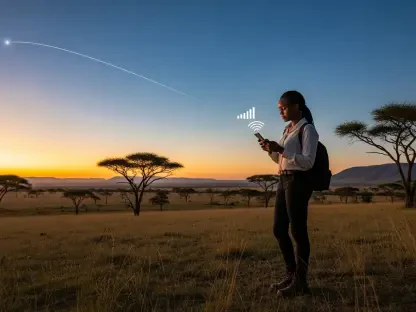The telecommunications landscape is on the brink of a monumental shift, with global data traffic projected to grow exponentially over the next decade, driven by the proliferation of IoT devices and immersive digital experiences. This surge in demand poses a critical challenge: how can networks evolve to support ultra-high speeds, near-zero latency, and massive connectivity without compromising efficiency or sustainability? Enter AI-driven 6G technology, the next frontier in wireless communication, poised to redefine connectivity through intelligent systems and innovative architectures. This review delves into the core components, recent advancements, real-world applications, and future potential of this groundbreaking technology, offering a detailed examination of its transformative impact on industries and society.
Defining the Next Generation of Connectivity
AI-driven 6G technology builds upon the foundation of 5G, aiming to deliver unprecedented performance with speeds potentially reaching terabits per second, latency in microseconds, and the capacity to connect billions of devices simultaneously. Unlike its predecessor, 6G integrates artificial intelligence at its core, enabling networks to self-optimize, predict user needs, and adapt dynamically to changing conditions. This fusion of AI and advanced wireless systems is not merely an upgrade but a paradigm shift, addressing the limitations of current infrastructure in handling complex, data-intensive environments.
The significance of this technology emerges against the backdrop of escalating global data demands, fueled by smart cities, autonomous systems, and the Internet of Things (IoT). AI plays a pivotal role by enhancing network management through predictive analytics and automated decision-making, ensuring efficiency even in high-density scenarios. As a driver of technological and economic progress, 6G stands at the forefront of the global telecom landscape, promising to unlock innovations that reshape how industries operate and how societies connect.
Technical Innovations and Core Features
Enhancing Coverage and Efficiency with AI
One of the standout features of AI-driven 6G lies in its ability to tackle coverage challenges inherent in the high-frequency spectrum, such as millimeter-wave and terahertz bands. Collaborations between industry leaders like Nokia and Rohde & Schwarz have demonstrated the power of AI and machine learning in extending uplink distances by up to 25%, a critical advancement for ensuring seamless connectivity in urban and remote areas alike. This improvement not only enhances user experience but also significantly reduces the costs associated with network rollout, making widespread deployment more feasible.
Real-world testing has been instrumental in validating these advancements, utilizing sophisticated equipment like vector signal generators and signal analyzers to simulate diverse conditions. Such rigorous methodologies confirm that AI can dynamically adjust signal parameters to overcome obstacles like interference and signal degradation. The implications are profound, as this technology paves the way for broader access to high-speed internet, even in challenging terrains or densely populated regions.
Optimizing Resources through Intelligent Systems
Beyond coverage, AI’s role in resource management marks a cornerstone of 6G’s technical prowess. By leveraging predictive algorithms, 6G networks can anticipate traffic patterns, allocate bandwidth efficiently, and minimize energy consumption, addressing the growing need for sustainable telecom solutions. These self-optimizing networks adapt in real time, ensuring optimal performance during peak usage periods without wasting resources during off-peak times.
The impact of such intelligent systems is particularly notable in environments with massive IoT deployments, where thousands of devices require simultaneous connectivity. Specific machine learning models enable precise load balancing and fault detection, reducing downtime and enhancing reliability. This capability is essential for supporting future ecosystems where high-density user scenarios, from stadiums to smart factories, demand flawless network operation without compromise.
Industry Trends and Recent Progress
The development of AI-driven 6G is accelerating through strategic partnerships and research initiatives that push the boundaries of connectivity. Collaborative efforts across Europe, Asia, and North America highlight a competitive race to dominate this space, with significant investments in integrating AI with complementary technologies like edge computing and quantum communication. These synergies aim to create networks that are not only faster but also more secure and responsive to real-time demands.
A notable trend shaping the 6G ecosystem is the emphasis on sustainability and interoperability, evident in the adoption of open architectures like Open RAN. This shift toward modular and flexible systems fosters innovation by allowing smaller players to contribute to the network infrastructure, breaking the monopoly of traditional giants. Such openness is critical for accelerating deployment and ensuring that 6G benefits a diverse range of stakeholders across the globe.
Global efforts also reflect a shared focus on addressing environmental concerns, with initiatives to reduce the carbon footprint of network operations gaining traction. From energy-efficient hardware to AI-driven power optimization, the industry is aligning technological progress with ecological responsibility. This convergence of goals underscores the dynamic nature of 6G development, balancing innovation with broader societal needs.
Transformative Applications and Use Cases
AI-driven 6G technology is set to revolutionize multiple sectors by enabling applications that were once deemed futuristic. In healthcare, for instance, ultra-low latency and high reliability could facilitate remote surgeries with real-time precision, connecting specialists to patients across continents. Similarly, in the automotive industry, 6G’s capabilities support autonomous vehicles through instantaneous data exchange, enhancing safety and navigation in complex urban environments.
Smart cities stand to gain immensely, with 6G enabling advanced urban planning through massive IoT networks that monitor traffic, energy usage, and public safety in real time. Pilot projects exploring holographic communication and immersive AR/VR experiences further illustrate the technology’s potential to transform entertainment and education, creating fully interactive digital worlds. These examples highlight how 6G can bridge physical and virtual spaces, redefining human interaction.
Unique use cases also emerge in critical scenarios like disaster response, where AI optimizes network performance to ensure uninterrupted communication during emergencies. Industrial automation benefits as well, with factories leveraging 6G for seamless coordination of robotic systems and real-time monitoring. The societal benefits of such enhanced connectivity are vast, promising greater accessibility and equity in accessing cutting-edge services across diverse communities.
Challenges Hindering Development
Despite its promise, AI-driven 6G faces significant technical hurdles, including spectrum constraints and the limitations of current hardware in supporting terahertz frequencies. The complexity of integrating AI at scale poses additional challenges, requiring robust frameworks to ensure stability and security across vast networks. Overcoming these barriers demands continuous innovation in materials science and algorithm design to keep pace with ambitious performance goals.
Regulatory obstacles further complicate the path forward, with standardization issues and privacy concerns surrounding AI data usage remaining unresolved. Global policy discrepancies create uneven playing fields, slowing collaborative progress and risking fragmented implementation. Addressing these concerns necessitates harmonized frameworks that prioritize ethical considerations alongside technological advancement.
Market and adoption barriers also loom large, with high deployment costs potentially limiting 6G’s reach, especially in underserved regions where the digital divide persists. The financial burden of infrastructure upgrades could delay widespread access, exacerbating inequalities. Ongoing research and international cooperation are vital to mitigate these issues, ensuring that the benefits of 6G are equitably distributed through targeted subsidies and innovative financing models.
Envisioning the Future of Connectivity
Looking ahead, AI-driven 6G technology holds the potential for groundbreaking advancements in algorithms and network architectures that could further elevate performance. Innovations in hardware, such as next-generation antennas and energy-efficient chipsets, are expected to address current limitations, paving the way for seamless integration with futuristic technologies over the next few years. The anticipated timeline for commercialization, likely within the coming decade, suggests a rapid evolution of telecom standards.
The long-term impact of 6G on global economies could be transformative, fostering new industries, reshaping workforce dynamics, and driving productivity through enhanced digital tools. Its role in addressing pressing challenges like climate change, through optimized resource use and smart infrastructure, positions it as a key enabler of sustainable progress. Speculation on redefined connectivity standards hints at a world where digital and physical boundaries blur, creating unprecedented opportunities for innovation.
Reflecting on the Journey and Path Ahead
Looking back, the exploration of AI-driven 6G technology revealed a landscape brimming with potential, marked by significant strides in coverage, efficiency, and application diversity. The integration of AI proved to be a game-changer, offering solutions to longstanding network challenges while opening doors to transformative use cases across industries. Despite the hurdles, the progress made underscored a collective commitment to pushing technological boundaries.
Moving forward, the focus should shift to actionable strategies that address regulatory and adoption barriers, ensuring that 6G’s benefits reach all corners of society. Collaborative frameworks between governments, industry leaders, and research bodies must prioritize ethical guidelines and inclusive deployment models. By investing in education and infrastructure for underserved areas, stakeholders can bridge the digital gap, turning the vision of universal connectivity into a tangible reality for future generations.









